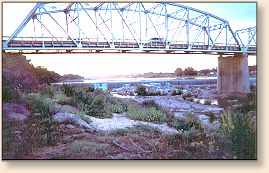 My most favorite place to fish is the Llano River. It
has beautiful bream and plentiful bass. This is a
beautiful river with cool clear spring fed waters. The
river begins in Sutton County as the North Llano Fork and
Edwards County as the South Llano Fork. The two come
together at the city of Junction, Texas. From here the
Llano runs out of Kimble County, through Mason County and
finally ending in Llano County where it joins with the
Colorado River at Lyndon B. Johnson Lake.
My most favorite place to fish is the Llano River. It
has beautiful bream and plentiful bass. This is a
beautiful river with cool clear spring fed waters. The
river begins in Sutton County as the North Llano Fork and
Edwards County as the South Llano Fork. The two come
together at the city of Junction, Texas. From here the
Llano runs out of Kimble County, through Mason County and
finally ending in Llano County where it joins with the
Colorado River at Lyndon B. Johnson Lake.
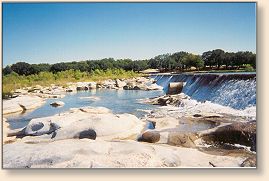 The river's course is through the Texas Hill Country, which consists
of the famous Pink Granite, which our state capitol is
constructed of. Also the Spotted Guadalupe Bass is found
here. This Texas native species of bass only exist in
the Texas Hill Country. Between the granite and the
limestone, which acts as a natural filter, the water
remain clear throughout its course. In many of the
small lakes formed by park dams, the bottom can be clearly
seen at depths of 30 feet. This clarity can make it a
real test of one's skills.
The river's course is through the Texas Hill Country, which consists
of the famous Pink Granite, which our state capitol is
constructed of. Also the Spotted Guadalupe Bass is found
here. This Texas native species of bass only exist in
the Texas Hill Country. Between the granite and the
limestone, which acts as a natural filter, the water
remain clear throughout its course. In many of the
small lakes formed by park dams, the bottom can be clearly
seen at depths of 30 feet. This clarity can make it a
real test of one's skills.
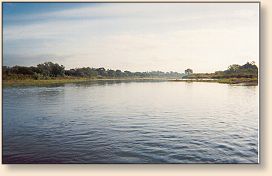 The flies used in this article are used from Castell, Texas,
down through Llano, Texas. They also work in other areas,
such as San Gabriel River and Brushy Creek, which will be,
included in future articles.
The flies used in this article are used from Castell, Texas,
down through Llano, Texas. They also work in other areas,
such as San Gabriel River and Brushy Creek, which will be,
included in future articles.
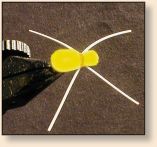 Spider patterns have been around awhile and there are many
variations. The one I use is quick and simple. Average
time for tying is about a minute each. My good friend
Scott introduced this surface terrestrial to me. He
purchased a couple from a local flieshop and was catching
fish after fish until the trees on the San Gabriel claimed
his last one. Since the River is only 10 minutes from my
house and it was lunchtime anyway, we went by the house and
I changed the recipe to tie a quicker pattern. The result
has been an extremely productive one.
Spider patterns have been around awhile and there are many
variations. The one I use is quick and simple. Average
time for tying is about a minute each. My good friend
Scott introduced this surface terrestrial to me. He
purchased a couple from a local flieshop and was catching
fish after fish until the trees on the San Gabriel claimed
his last one. Since the River is only 10 minutes from my
house and it was lunchtime anyway, we went by the house and
I changed the recipe to tie a quicker pattern. The result
has been an extremely productive one.
Spider
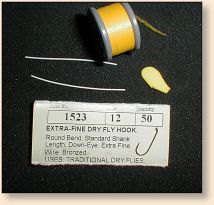 Recipe:
Recipe:
Hook: Size 12 or10, 2X.
Body: Yellow closed cell foam.
Legs: White rubber.
Thread: Yellow or black.
Zap a Gap: For attaching the foam body to the thread bed.
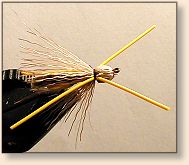 The other pattern, which works really well, is the Hopper.
There are many variations of the hopper and just about all
of them work on the Llano. Small size 12 to 10 for bream
and larger sizes for bass. The theory of bigger flies equal
bigger fish is generally true, but it also equals fewer fish.
For me the X-Hopper has worked very well.
The other pattern, which works really well, is the Hopper.
There are many variations of the hopper and just about all
of them work on the Llano. Small size 12 to 10 for bream
and larger sizes for bass. The theory of bigger flies equal
bigger fish is generally true, but it also equals fewer fish.
For me the X-Hopper has worked very well.
Hopper
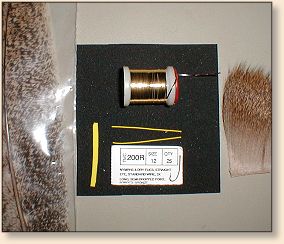 Recipe:
Recipe:
Hook: Size XX, 3X.
Body: Yellow closed cell foam.
Legs: Yellow or green rubber.
Thread: Black.
Ribbing: Gold tinsel over laying thread.
Head: Natural deer hair tied in bullet head fashion.
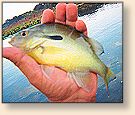 The method I use for fishing these flies is really simple and
is always in moving water. I don't know if these will work
on still water, I don't frequent any lakes here so if you
decide to try them the method will probably have to vary.
The method I use for fishing these flies is really simple and
is always in moving water. I don't know if these will work
on still water, I don't frequent any lakes here so if you
decide to try them the method will probably have to vary.
 The flies work best when cast up to the bank while wading out
mid-channel when possible. Typically, due to the water clarity
I will wade in the water carefully and try not to approach
the banks any closer than 20 to 30 feet. The deeper I wade,
the less the fish can see above water movement. As long as
my body movements below the water line are at a minimum, it
does not seem to bother them. In fact on several occasions
I have had bream, bass and catfish come quite close to me
until they see the above water movement of my casting.
The flies work best when cast up to the bank while wading out
mid-channel when possible. Typically, due to the water clarity
I will wade in the water carefully and try not to approach
the banks any closer than 20 to 30 feet. The deeper I wade,
the less the fish can see above water movement. As long as
my body movements below the water line are at a minimum, it
does not seem to bother them. In fact on several occasions
I have had bream, bass and catfish come quite close to me
until they see the above water movement of my casting.
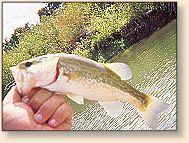
Look for an area that has brush, weeds, grass or trees
overhanging the water. Also any large rocks protruding
into the river harbor bream and bass. Stand facing the
bank and cast the spider at about 45 degrees up river from
your position to within a foot of the bank. Now move your
rod tip across your body at the same speed as the current.
This allows the spider to move at the same speed as the
current giving the appearance of a terrestrial caught in
the current. As soon as your rod tip gets at a position
of 45 degrees down river, stop your rod movement and let
the current take your spider down river until it straightens
out the line. Once the line is straight out strip the line
back in and repeat the process. There have been times when
it took a few casts to get anything and times when I have
pulled in fish on every cast.
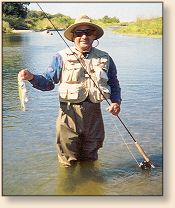 Now here is the little secret of this method. When the
spider is cast up river and you are moving the rod tip
at the current speed, this is the Bream phase. By this
I mean that the bream will typically strike as the spider
is moving at the natural current speed. Any faster and
they usually will not touch it. When the rod tip reaches
the down river stopping point the current will catch the
line and cause the spider to pick up speed and now is in
the Bass phase. From this point including stripping it
in causes the spider to produce turbulence in the water
and this entices the bass to strike which have also have
been watching the spider. This method has worked
consistently on every trip for those whom I have
this method to. Just ask Ed, here with his first bass
on a flyrod.
Now here is the little secret of this method. When the
spider is cast up river and you are moving the rod tip
at the current speed, this is the Bream phase. By this
I mean that the bream will typically strike as the spider
is moving at the natural current speed. Any faster and
they usually will not touch it. When the rod tip reaches
the down river stopping point the current will catch the
line and cause the spider to pick up speed and now is in
the Bass phase. From this point including stripping it
in causes the spider to produce turbulence in the water
and this entices the bass to strike which have also have
been watching the spider. This method has worked
consistently on every trip for those whom I have
this method to. Just ask Ed, here with his first bass
on a flyrod.
Next Stop, Brushy Creek. Johnny, AKA Hillfisher
|

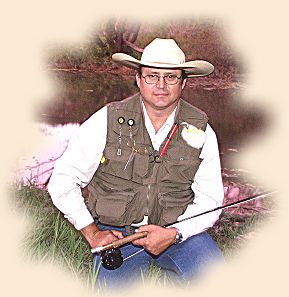

 The river's course is through the Texas Hill Country, which consists
of the famous Pink Granite, which our state capitol is
constructed of. Also the Spotted Guadalupe Bass is found
here. This Texas native species of bass only exist in
the Texas Hill Country. Between the granite and the
limestone, which acts as a natural filter, the water
remain clear throughout its course. In many of the
small lakes formed by park dams, the bottom can be clearly
seen at depths of 30 feet. This clarity can make it a
real test of one's skills.
The river's course is through the Texas Hill Country, which consists
of the famous Pink Granite, which our state capitol is
constructed of. Also the Spotted Guadalupe Bass is found
here. This Texas native species of bass only exist in
the Texas Hill Country. Between the granite and the
limestone, which acts as a natural filter, the water
remain clear throughout its course. In many of the
small lakes formed by park dams, the bottom can be clearly
seen at depths of 30 feet. This clarity can make it a
real test of one's skills.
 Spider patterns have been around awhile and there are many
variations. The one I use is quick and simple. Average
time for tying is about a minute each. My good friend
Scott introduced this surface terrestrial to me. He
purchased a couple from a local flieshop and was catching
fish after fish until the trees on the San Gabriel claimed
his last one. Since the River is only 10 minutes from my
house and it was lunchtime anyway, we went by the house and
I changed the recipe to tie a quicker pattern. The result
has been an extremely productive one.
Spider patterns have been around awhile and there are many
variations. The one I use is quick and simple. Average
time for tying is about a minute each. My good friend
Scott introduced this surface terrestrial to me. He
purchased a couple from a local flieshop and was catching
fish after fish until the trees on the San Gabriel claimed
his last one. Since the River is only 10 minutes from my
house and it was lunchtime anyway, we went by the house and
I changed the recipe to tie a quicker pattern. The result
has been an extremely productive one.
 The other pattern, which works really well, is the Hopper.
There are many variations of the hopper and just about all
of them work on the Llano. Small size 12 to 10 for bream
and larger sizes for bass. The theory of bigger flies equal
bigger fish is generally true, but it also equals fewer fish.
For me the X-Hopper has worked very well.
The other pattern, which works really well, is the Hopper.
There are many variations of the hopper and just about all
of them work on the Llano. Small size 12 to 10 for bream
and larger sizes for bass. The theory of bigger flies equal
bigger fish is generally true, but it also equals fewer fish.
For me the X-Hopper has worked very well.

 The flies work best when cast up to the bank while wading out
mid-channel when possible. Typically, due to the water clarity
I will wade in the water carefully and try not to approach
the banks any closer than 20 to 30 feet. The deeper I wade,
the less the fish can see above water movement. As long as
my body movements below the water line are at a minimum, it
does not seem to bother them. In fact on several occasions
I have had bream, bass and catfish come quite close to me
until they see the above water movement of my casting.
The flies work best when cast up to the bank while wading out
mid-channel when possible. Typically, due to the water clarity
I will wade in the water carefully and try not to approach
the banks any closer than 20 to 30 feet. The deeper I wade,
the less the fish can see above water movement. As long as
my body movements below the water line are at a minimum, it
does not seem to bother them. In fact on several occasions
I have had bream, bass and catfish come quite close to me
until they see the above water movement of my casting.
 Now here is the little secret of this method. When the
spider is cast up river and you are moving the rod tip
at the current speed, this is the Bream phase. By this
I mean that the bream will typically strike as the spider
is moving at the natural current speed. Any faster and
they usually will not touch it. When the rod tip reaches
the down river stopping point the current will catch the
line and cause the spider to pick up speed and now is in
the Bass phase. From this point including stripping it
in causes the spider to produce turbulence in the water
and this entices the bass to strike which have also have
been watching the spider. This method has worked
consistently on every trip for those whom I have
this method to. Just ask Ed, here with his first bass
on a flyrod.
Now here is the little secret of this method. When the
spider is cast up river and you are moving the rod tip
at the current speed, this is the Bream phase. By this
I mean that the bream will typically strike as the spider
is moving at the natural current speed. Any faster and
they usually will not touch it. When the rod tip reaches
the down river stopping point the current will catch the
line and cause the spider to pick up speed and now is in
the Bass phase. From this point including stripping it
in causes the spider to produce turbulence in the water
and this entices the bass to strike which have also have
been watching the spider. This method has worked
consistently on every trip for those whom I have
this method to. Just ask Ed, here with his first bass
on a flyrod.